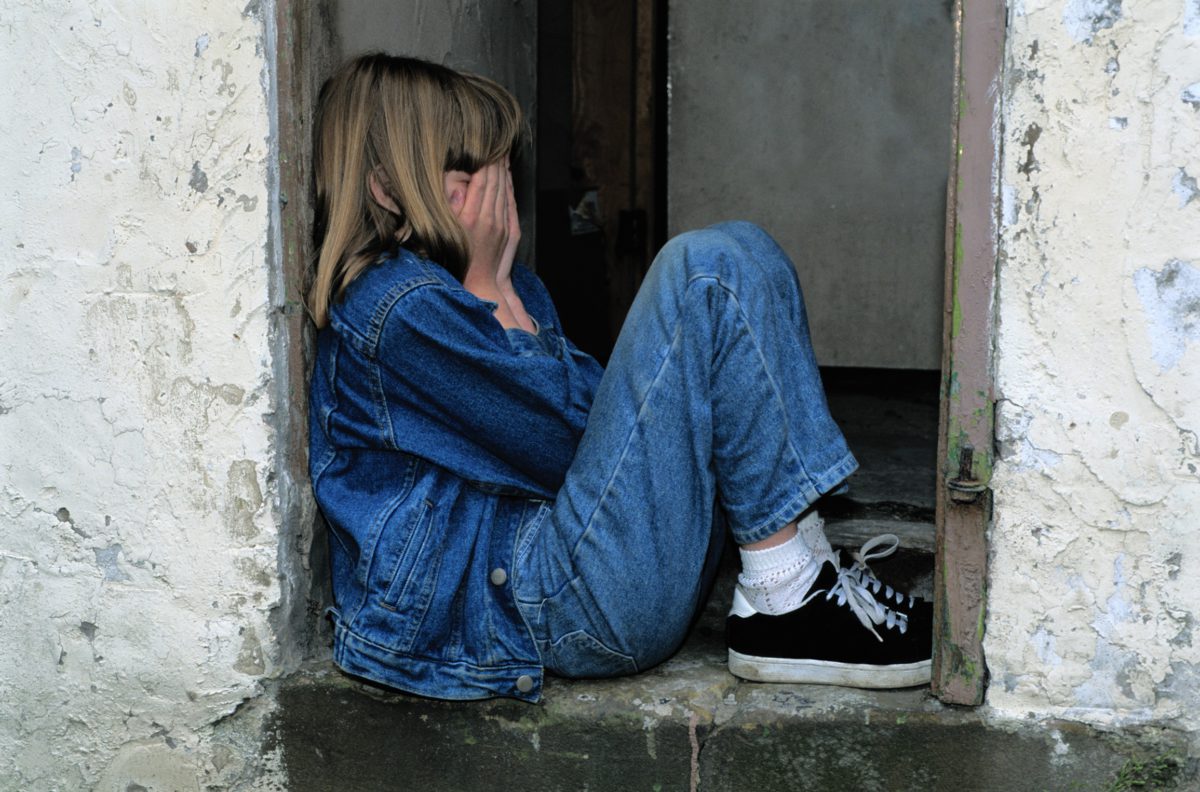
Number Of Arrests Involving Juveniles In 2019 Was At Near 40-Year Low
By a Biometrica staffer
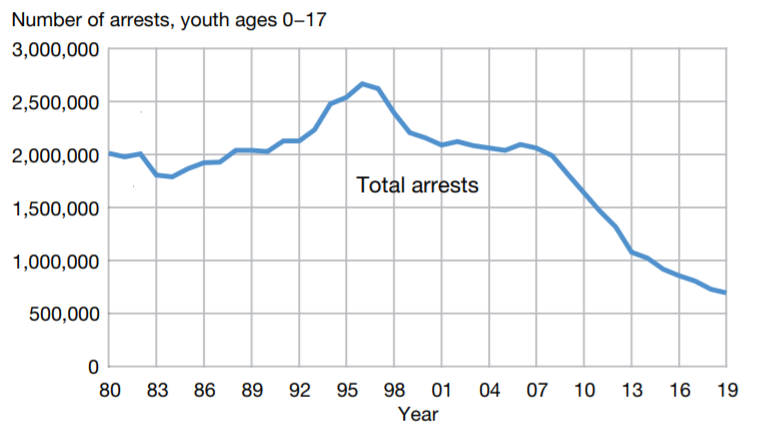
In 2019, the number of arrests involving juveniles — persons younger than 18 — was estimated to be less than 700,000. That’s the lowest level since at least 1980, with much of the decline happening in the last decade, according to a report published by the Department of Justice’s (DOJ) Office of Justice Programs (OJP) this month. The report draws on arrest estimates developed by the Bureau of Justice Statistics (BJS) and the National Center for Juvenile Justice based on analyses of data from the Federal Bureau of Investigation’s (FBI) Uniform Crime Reporting (UCR) program.
Arrests of juveniles peaked in 1996 at nearly 2.7 million. It has been on a more or less steady decline ever since, briefly trending upwards in the 2005-07 period. In 2019, the total number of arrests involving juveniles was estimated to be 696,620. When analyzed in terms of the types of crimes committed, juvenile arrests for violent crimes also decreased 40% between 2010 and 2019. Another trend that the report notes is that relative declines in arrests have been greater for boys than for girls across many offenses. As a result, the female share of juvenile arrests has grown since 1980.
We take you through some of the other key statistics and trends identified by the DOJ-OJP’s juvenile arrests report.
Overall Trends
On the whole, juvenile arrests have been on the decline for more than two decades, but patterns vary by demographic group and offense. Between 2010 and 2019, the number of juvenile arrests fell 58%, between 2015 and 2019 they fell 24%, and between 2018 and 2019, they fell 4%. Of the 696,620 estimated juvenile arrests, 31% were female, 32% were younger than 15, and 63% were White.
Gender-Based Trends
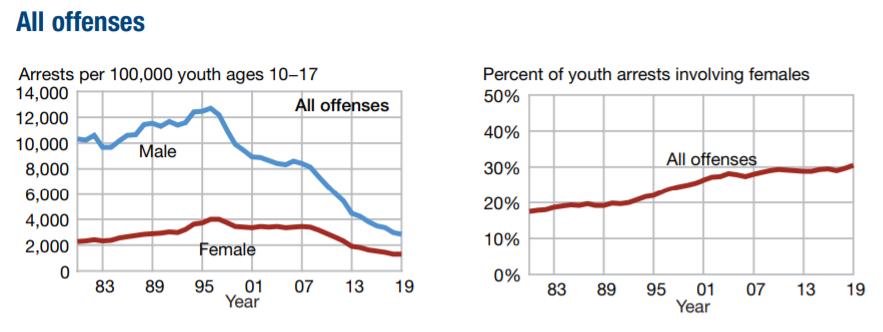
From 2010 through 2019, arrests of juvenile females decreased less than male arrests in most offense categories (for example, robbery, aggravated and simple assault, burglary, and drug abuse violations) the report says. In 2019, there were 212,650 arrests of females younger than age 18 and 483,970 arrests of males.
Although males accounted for the majority (69%) of juvenile arrests overall in 2019, the female share was relatively high for certain offenses: Those included liquor law violations (42%), larceny-theft (40%), simple assault (38%), and disorderly conduct (37%). Females accounted for 33% of juvenile Property Crime Index arrests and 21% of juvenile violent crime arrests in 2019.
Violent Crime Trends
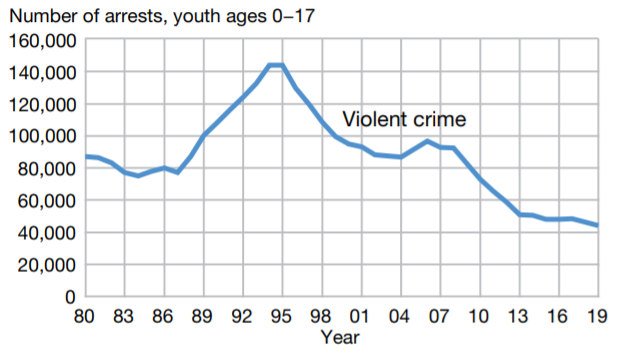
As we said earlier, juvenile arrests for violent crimes decreased 40% between 2010 and 2019. It was down 8% between 2015 and 2019, and 5% between 2018 and 2019. Within violent crime categories, the largest portion of the pie was aggravated assaults, for which there were 27,070 juvenile estimated arrests in 2019. But that number was also down 40% between 2010 and 2019. The next largest category in terms of numbers was robbery with 16,080 estimated juvenile arrests, a decline of 41% between 2010 and 2019.
After falling 71% between 1993 and 2004, juvenile arrests for murder increased through 2007, then declined 46% through 2012 to reach the lowest level in three decades, the report says. The number of juvenile arrests for murder increased each year between 2012 and 2018, then fell 6% through 2019.
Property Crime Trends
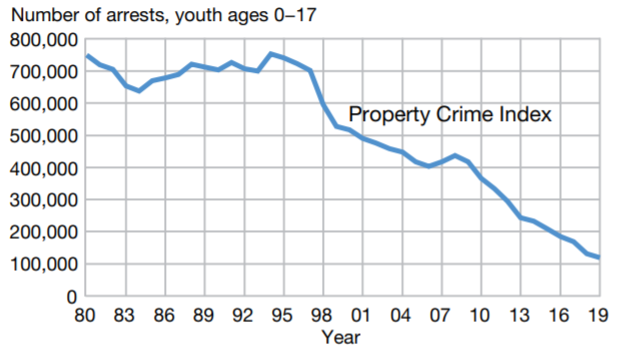
Law enforcement agencies nationwide consistently report data on four offenses that form the Property Crime Index — burglary, larceny-theft, motor vehicle theft, and arson — to determine trends in the number of property crime arrests. “For the period 1980–1994, during which juvenile violent crime arrests increased substantially, juvenile property crime arrests remained relatively constant. After this long period of relative stability, juvenile property crime arrests began a 25-year decline,” the report says.
Between 1994 and 2019, the number of juvenile arrests for property crime fell 84% and reached its lowest level since at least 1980. Between 2010 and 2019, juvenile arrests declined for: Burglary (68%), larceny-theft (70%), motor vehicle theft (14%), and arson (61%). The total number of estimated juvenile arrests for property crimes (119,790) was much higher than those for violent crimes in 2019. Within property crimes, larceny-theft accounted for the largest portion of the pie with 83,690 estimated arrests, burglary was next with 20,700, motor vehicle theft with 13,610 and arson with 1,800. When it comes to the larceny-theft estimated arrests, 40% involved females, 30% involved youth younger than 15, and more than half (55%) involved White youth.
Age-Based Trends
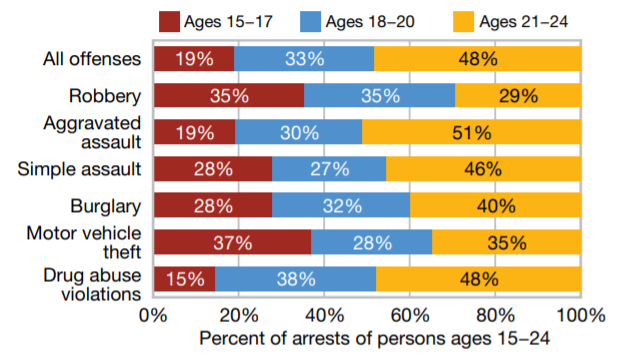
The rate of arrests of older juveniles was lower than those for young adults in 2019. Across most offenses, older juveniles accounted for a smaller proportion of arrests than young adults aged 18–20 or those aged 21–24. The overall arrest rate for older juveniles and those for young adults aged 18–20 have followed a similar pattern. Rates peaked in 1996 for both groups, then declined (76% and 66%, respectively) to reach their lowest level in 2019. In comparison, the arrest rate for adults ages 21–24 peaked in 1989 and then declined 54% by 2019 to its lowest level since at least 1980.
Other Demographic Trends
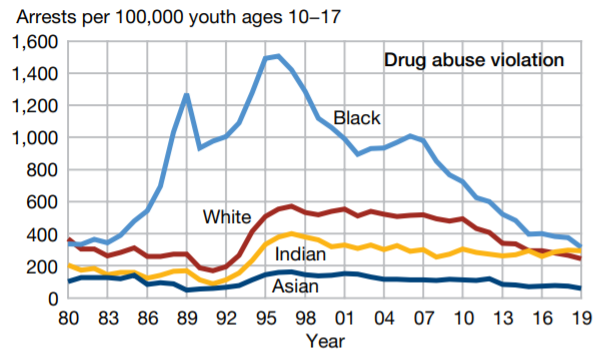
In the last 10 years, the drug arrest rate declined 56% for Black youth, 51% for White youth, 46% for Asian youth, and 3% for American Indian youth. The Black-to-White ratio in the drug abuse violation arrest rate has also narrowed in recent years, largely influenced by the considerable decline in the Black arrest rate since the mid-1990s (79% vs. 52% for the White arrest rate). The ratio peaked in 1991, at nearly 6 to 1. By 2019, the Black arrest rate was 1.3 times the White rate.
Arrest rates for murder and robbery were higher for Black youth than youth of other races in 2019, the report says. But the robbery arrest rate for Black youth has been on the decline, unlike the trend seen among other groups. Between 2008 and 2019, the robbery arrest rate for Black youth fell 57%, and reached its lowest level since at least 1980. The disparity gap between Black juvenile arrests and White is also narrowing.
The murder arrest rate for White juveniles reached a historic low in 2013, 82% below its 1994 peak, while the rate for Black juveniles touched a low point one year earlier, 87% below its 1993 peak. Since those respective lows, the rate for White youth increased 46% through 2019, while the rate for Black youth increased 47% through 2017 then declined 23% through 2019. The disparity in black-to-white juvenile murder arrest rates peaked in 1993, when the black rate was nearly nine times the white rate. Following the decline in the murder arrest rate for black youth, the ratio fell below 5 to 1 in 2019.
Liquor law violations are one of the few offenses for which rates are higher for American Indian juveniles than for other race groups. The American Indian rate in 2019 was more than twice the White rate, nearly 8 times the rate for Black youth, and more than 14 times the rate for Asian youth.
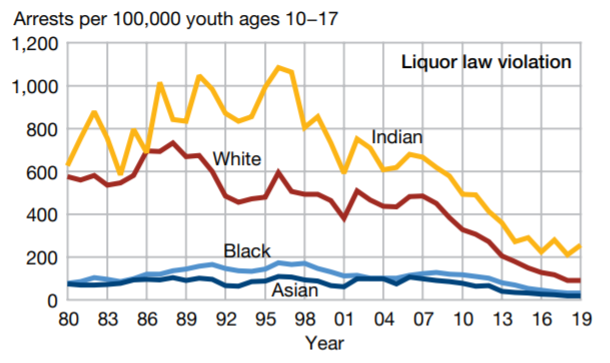
In other related news, UC San Diego said in a post on its website this month that disrupting the school-to-prison pipeline will be the debut project of the nation’s first civility research center to address juvenile justice reform. The project by the National Conflict Resolution Center’s (NCRC) at UC San Diego will study, evaluate and refine a national model of best practices to promote national criminal justice reform and reduce mass incarceration, the post added.
“The first juvenile court in the United States opened in Chicago in 1899 because of the belief that less stringent rules should apply to younger populations who ran afoul of the law. It wasn’t until 1945 that all states had a juvenile court. Now with a better understanding of child development, juvenile justice systems across the United States are reorienting themselves. Many states and municipalities are now adopting research-based approaches to juvenile justice reform, which demonstrate that children have better outcomes when their needs are met in the community, and that many youth offenders outgrow delinquent behavior as they become more engaged with school and work,” the UC San Diego post continues.